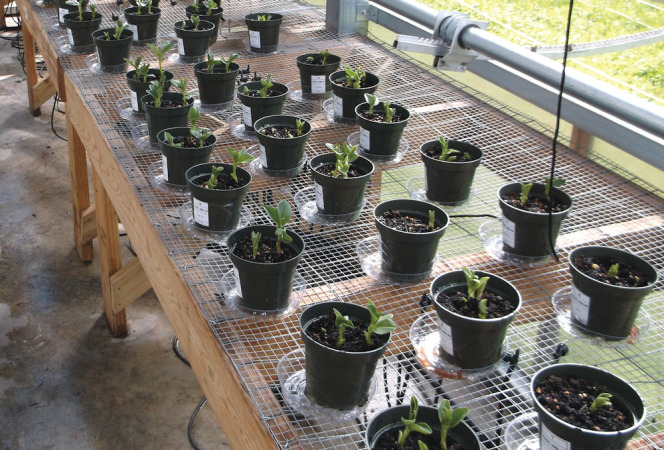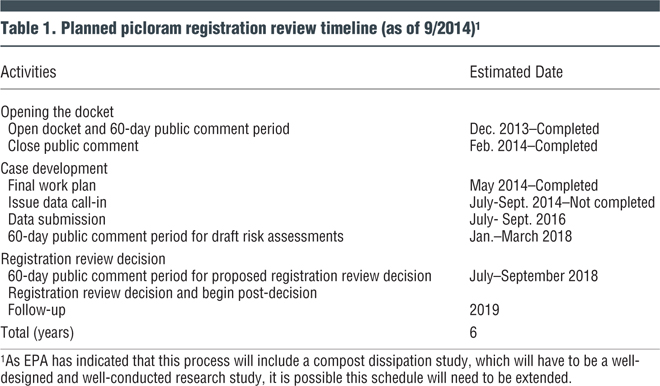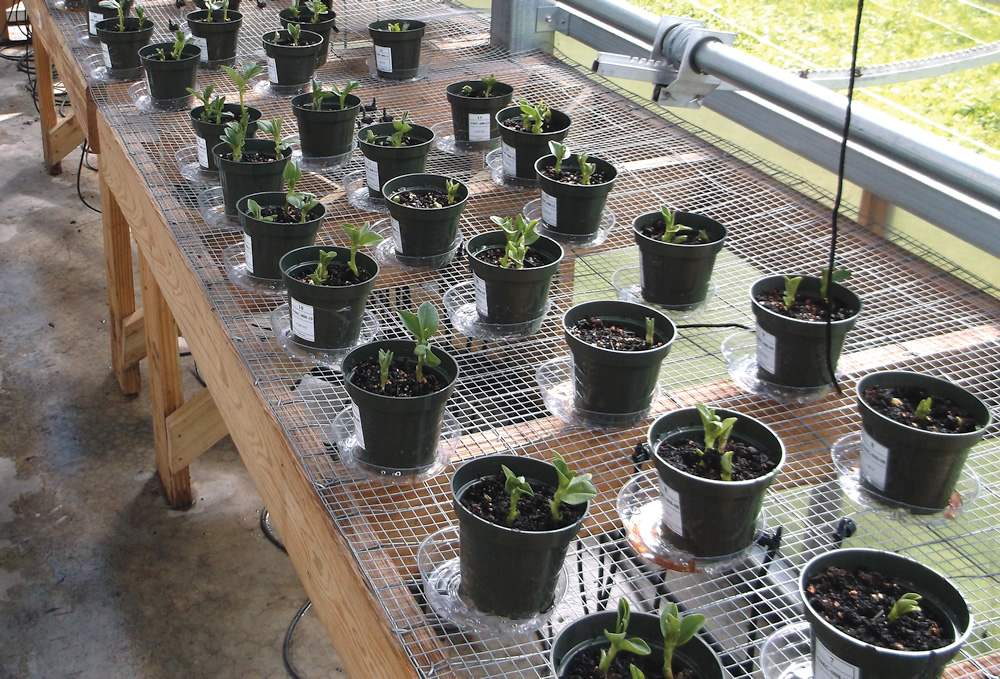U.S. EPA’s final work plans for clopyralid, picloram and aminopyralid include development of testing methods to detect herbicide residues in compost. And composting facilities fine-tune strategies to protect against impacts.
Craig Coker
BioCycle January 2015

Green Mountain Compost (GMC) conducts its own bioassays, testing every 100 cubic yards of compost produced using red clover and fava beans.
Persistent herbicides appeared as a problem for composting facilities when yard trimmings compost produced by the City of Spokane, Washington was found to be contaminated with them in 2000. The four main persistent herbicides of concern are clopyralid, picloram, aminopyralid and aminocyclopyrachlor. (One formulation of aminocyclopyrachlor, called Imprelis, was ordered off the market by U.S. EPA in August 2011 due to evergreen tree damage, but other formulations are still on the market.) These herbicides are designed to be persistent and systemic in their action against broadleaf weeds. They are registered for use on rights-of-way (including roadsides, electric utility lines, railroads, etc.), industrial sites, natural areas, and pastures and grazed areas around these sites. They can end up in composting facilities that take in grass clippings, hay, straw and manures from herbivorous animals that have grazed in pastures or eaten hay or grains containing persistent herbicides. Research in 2013 by Ohio State University (OSU) testing compost samples from 60 composters around the U.S. using green bean bioassay techniques detected persistent herbicides with an adverse effect level of 0.5 parts per billion (ppb) in at least two of the 60 samples (analysis is still underway).
Herbicides are regulated by EPA and the states (usually that state’s agriculture office) register or license herbicides for use in their states. EPA receives its authority to register these materials under the Federal Insecticide, Fungicide, and Rodenticide Act (FIFRA), which defines a “pesticide” to include “(2) any substance or mixture of substances intended for use as a plant regulator, defoliant, or desiccant.” States are authorized to regulate pesticides under FIFRA and under state pesticide laws. States may place more restrictive requirements on pesticides than EPA. Pesticides must be registered both by EPA and the state before distribution.
Pesticide Registration Review
In 2006, EPA initiated a new program called registration review to reevaluate all pesticides on a regular cycle. The intent is for EPA to review each registered pesticide at least every 15 years to determine whether it continues to meet the FIFRA standard for registration. Among other things, FIFRA requires that a pesticide generally will not cause unreasonable adverse effects on the environment. Registration review is intended to ensure that each pesticide’s registration is based on current scientific and other knowledge regarding the pesticide, including its effects on human health and the environment. The registration review process for clopyralid, picloram and aminopyralid began in 2013. Pesticides can continue to be sold during this process.
EPA initiates a registration review by establishing a public docket for a pesticide registration review case and opening the docket for public comment. Several composters and the US Composting Council have filed public comments on the dockets for all three persistent herbicides — clopyralid, picloram and aminopyralid — requesting EPA withhold approval of reregistration of these persistent herbicides due to the potentially adverse effects on composting facilities and composts. Based in part on these submitted comments, EPA develops a Preliminary Work Plan (PWP) to lay out its plan for evaluations of pesticides, including updated risk assessments and data needs. These PWPs are available for comments and based on comments received, EPA publishes the Final Work Plan (FWP).
The PWP for picloram (see Table 1) was released in December 2013 and the PWPs for clopyralid and aminopyralid were released in March 2014. Among the anticipated data needs stated are data on environmental chemistry methods for testing soils, water and compost for the presence of the herbicides, and a “Compost Dissipation Study,” which should establish degradation rates for the herbicides in composting piles (and prove or disprove a claim that the herbicides actually concentrate in compost due to the faster degradation of organic matter).
During the 60-day public comment periods for each PWP, the EPA received 73 public comments on all three PWPs, many from composters and the US Composting Council. The FWPs were published in May 2014 for picloram and in September 2014 for clopyralid and for aminopyralid. (pages for aminopyralid, clopyralid and picloram) The three FWPs are similar in content and planned direction. The EPA plans to require the development of environmental chemistry testing methods for state agricultural laboratories to use in detecting herbicide residues in compost. Dow Agro-Sciences (DAS), the company that produces these herbicides, distributed a revised laboratory procedure to laboratories in Spring 2014, but only one laboratory could successfully replicate the procedure.
EPA also intends to conduct risk assessments and compost dissipation studies to understand more about degradation rates for these herbicides during composting. The dissipation studies have not yet been designed, but may be based on radiocarbon isotope studies as DAS has been using C-14-labeled herbicides to study their persistence in soils. Radiocarbon analysis using C-14 is used to understand the decay rates of substances containing that radioactive isotope of carbon. (C-14 is formed by the reaction of atmospheric nitrogen with cosmic rays. It then combines with oxygen to form CO2, which is taken up by plants and animals.) Because it has a defined half-life, measuring the amount of C-14 in plant or animal tissue (or soils) defines how old it is.
It is not clear yet that these proposed compost dissipation studies will establish any definitive time period for adequate decay of these herbicides. Tom Moreau, General Manager of the Chittenden (VT) Solid Waste District (CSWD) — and one of the leading composting industry authorities on the persistent herbicides problem — observed: “During the public comment period that ended on May 27, 2104, Dave Barnekow of Dow wrote that Dow had already completed a bench scale analysis of aminopyralid in compost: ‘Aminopyralid residues did not decline appreciably during the thermophilic or mesophilic phases of the composting process. These results indicate that composting process is not likely to be a useful technique to mitigate aminopyralid residue in compost inputs.’” Other studies at OSU have shown that although the concentration of aminocyclopyraclor remained nearly constant, up to 50 percent of it was degraded during 200 days of composting when total organic matter loss was considered.
The next major opportunity for public comment about the registration decision for these herbicides will come in mid-2018 with an opportunity to comment on EPA’s risk assessments. The schedule for public comment on the proposed reregistration decision will be in late 2018 or early 2019. Given the complexities of the science behind these investigations, it is likely these schedules will slip. Composters who handle, or wish to handle, feedstocks that could potentially contain these herbicides will need to develop programs and protocols for dealing with them. The remainder of this article offers steps that composters should consider.
Feedstock Management
The most effective way to keep persistent herbicides from affecting compost quality is to simply not accept any materials known or likely to be contaminated. However, that may be easier said than done. These herbicides have been found in hay animal bedding and horse and dairy manure (the herbicide is in the grain-based animal feed). Clopyralid was found in compost made from food scraps at 5.2 ppb in 2012 by DAS from samples submitted by the Vermont Agency of Agriculture. Composters should exercise due diligence in accepting new manure feedstocks, inquiring as to sources of hay and as to whether the hay farmer used one of these herbicides.
Unlike testing for heavy metals in feedstocks, testing for the presence of these herbicides is much more complex. Only two or three analytical laboratories have the experience, equipment and staff to accurately detect these herbicides. These include DAS (which is not a commercial laboratory set up to do sampling), Anatek (Moscow, ID) and EPL Bio Analytical Services (Niantic, IL). “During the Vermont Agency of Agriculture investigation of our persistent herbicide problem in 2012, it took a long time to get results from DAS,” notes Moreau of CSWD. “I had to wait three to four months for results during the investigation. We now send samples to one of the commercial labs, which have fairly good turnaround times.” (CSWD’s Green Mountain Compost facility is in Williston, Vermont (see box for BioCycle’s coverage of CSWD’s persistent herbicide experiences).)
Lab fees for herbicide analysis can exceed $500 per sample for clopyralid, picloram and aminopyralid. Knowing the concentration of a herbicide allows a composter to use recipe algebra to dilute the concentration down to a possibly safe level, but as the herbicides may increase in concentration during composting (due to more rapid decay of organic matter), the recipes need to be very conservatively built.
In 2010, the U.S. Department of Agriculture’s National Institute for Food and Agriculture issued a grant to a Pennsylvania company to develop a quick field test for the presence of these persistent herbicides. Using a technology similar to home pregnancy test kits (known as ELISA or Enzyme-Linked ImmunoSorbent Assay), it was originally believed this simple yes-or-no test could allow composters to conduct their own testing. However, this research has not yielded a workable testing device to date.
Process Management
One operational modification that Green Mountain Compost (GMC) is reporting with success is to add high carbon wood ash to its recipe. There is no real definition of what constitutes a high carbon wood ash, but it is essentially an ash from an inefficient wood burning furnace or boiler that has a lot of unburned or partially burned wood in it. GMC is adding ash at a ratio of 2 to 5 percent by volume. “It essentially acts like activated carbon and binds the herbicide to the carbon molecules,” explains Frederick Michel, an Associate Professor at Ohio State University, who has been testing the effect of high carbon wood ash on binding persistent herbicides. “Our research is showing that by adding this type of ash at 2 percent by volume, the No-Observed Adverse Effect Level (NOAEL) rises from a concentration of 0.5 ppb to 10 ppb and with activated carbon, the NOAEL rises to 100 ppb.” (The NOAEL is the highest tested concentration of a substance (like a drug or a chemical) at which no adverse effect is observed where higher concentrations would show an adverse effect.) Michel has also tested biochar and zeolites (zeolites are microporous, aluminosilicate minerals commonly used as commercial adsorbents and catalysts) and a commercial modified silica product, Osorb®, but with no success to date.

GMC’s bioassay greenhouse, attached to the rear of its office building (left) has a concrete floor, automatically operated louvers and internal heat sensors that control louver openings.
The other operational modification that GMC (and others) are doing is to conduct its own bioassays or use a test like Woods End Laboratories’ Plant Injury Risk Management tool. GMC has an on-site bioassay greenhouse and tests every 100 cubic yards (cy) of compost produced using red clover (often used in herbicide bioassays) and fava beans, which have large leaves and are quick to show the leaf-curling damage of a persistent herbicide. GMC can see results in the fava bean pots within two weeks of growth. Each test is run in triplicate against a control, also in triplicate. The growth media is two parts compost to one part peat-based growing media (by volume). The controls are just peat-based growing media.
The greenhouse at GMC has a concrete floor, automatically-operated louvers and internal heat sensors that control louver openings. “We spend about 40 man-hours per month on the bioassay testing,” notes Dan Goossen, General Manager of GMC, “and with the ash addition, I think it’s adding about $1.00 to $2.00/ton to our processing costs.”
Restoring Confidence
Losing compost customers is never an enjoyable process for a composting facility, no matter what the reason. Losing one because the customer experienced damage from persistent herbicides in the compost is even harder, because it takes a compelling reason for them to return. “A lot of our customers have returned,” adds Goossen. “I think it’s because we were forthright, honest and respectful when the herbicide problem occurred in 2012. We explained what we were doing to find the causes, and we’ve kept them informed on our process management changes to deal with the problem. I don’t think customers really blamed GMC for the problem.”
Clearly, it is going to be several years before all the research into herbicide persistence in composting is complete. Given the advantages of these herbicides in controlling broadleaf weeds in agriculture, few expect EPA will not reregister these compounds later in this decade. Composters who wish to have potentially contaminated feedstocks in their recipes need to develop a combination of feedstock, operations and product management protocols to minimize the possibility of a bad product getting into the market. And patience will help too. “We tested about 6,500 cy of contaminated product in 2012 and found herbicide concentrations of between 3 and 9 ppb,” says Moreau. “We believe it’s dropped a little since then and we’re arranging for new testing to be done to find out how much it has dropped.”
Craig Coker is a Contributing Editor to BioCycle and a Principal in the firm Coker Composting & Consulting (www.cokercompost.com), near Roanoke VA. He can be reached at craigcoker@comcast.net.















